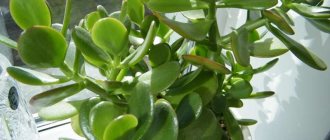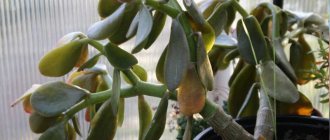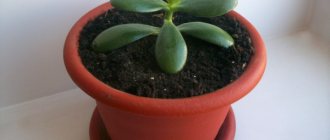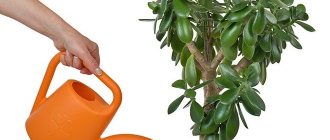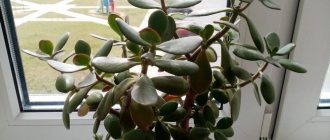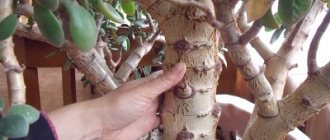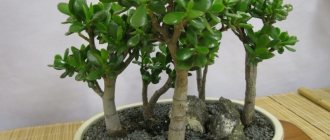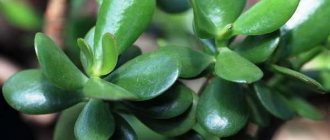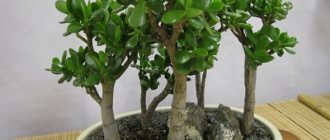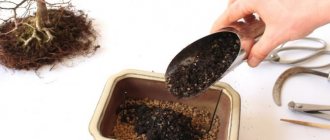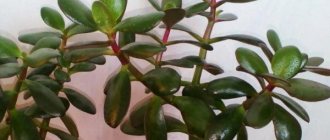There are more than 300 species of Crassula. The birthplace of the money tree is South Africa. Our most popular indoor plants are Crassula ovata and Crassula arborescens. Both species have fleshy, silver-gray, shiny, oval-shaped leaves. They produce many shoots and develop quickly into large, gnarled specimens with a huge crown and a height of up to 1 meter.
Crassula arborescens blooms, having reached the age of 10, with small pink or white flowers. According to Feng Shui, the plant attracts money to the house and helps improve the financial situation. That’s why they love to keep it not only at home, but also in offices.
Feng Shui pays great attention to the money tree - where to place the coins, what ribbon to tie, where to put it. The plant is unpretentious and does not require complex care. And yet it has its own characteristics. In order for it to develop well and bring good luck, it needs to be properly looked after.
The Crassula genus, to which Crassula belongs, includes a wide variety of plants. It even includes varieties for aquariums. The fat woman is quite unpretentious and easy to care for. Therefore, even a novice florist will not cause any trouble with the money tree.
Types of Crassula
The most common types of money trees are:
- oval Crassula (Crassula ovata);
- tree crassula (Crassula arborescens);
- crassula minor;
- Crassula Sunset;
- Crassula crescent;
- Crassula Alstonii;
- Crassula Campfire.
general characteristics
Crassula is one of the most famous and widespread succulents, which came to us from South Africa. It received the name “money tree” because of the characteristic shape of the leaves. Volumetric and round, they resemble coins. In nature, their main purpose is to store water. It is due to this that the fat woman is unpretentious and takes root well in arid regions.
The largest varieties reach 2 m, branch and grow a lush crown, but for this they require constant care. In nature, this is a flowering plant with a long flowering period - up to 3 months, but this is almost impossible to achieve in an apartment. But there is a downside: the absence of fragrant flowers and pollen makes the fat plant almost completely hypoallergenic.
Lighting and location
Crassula is a succulent. The plant should be located where it is light, even sunny, but not on the windowsill at noon. The leaves will turn red and then wither and fall off.
The fat woman also needs fresh air. In summer, the plant can be taken out into the garden or onto the balcony in a bright, but not sunny, place protected from rain. In winter, it is important to provide the money tree with coolness (10 degrees) and it is better to move it to the south side. When wintering is too warm, long, unsightly shoots are formed.
What is a flower
The money tree plant originated from Africa. It belongs to the genus of succulents and has thick, succulent leaves that are capable of storing moisture. This, in particular, helps it survive in the natural environment. Also, under natural conditions, the plant is capable of blooming, but this cannot be achieved when grown at home.
In nature it grows into a tall tree up to 4 meters. Care at home helps the flower grow up to 1-2 meters in height. Of course, lower than its “wild” counterpart, but still not bad for a houseplant.
Money tree watering mode
In summer, under indoor conditions, the soil in a pot with Crassula should be moderately moist. In the garden, the plant requires more watering. If it’s hot outside, at least 2 times a week; on cool days, once is enough. But keep in mind that the soil should never dry out. It is very important! Watering the plant in winter is enough 2 times a month.
Tips and rules for growing and caring for plants
Most often, flower growers grow the Ovata species of Crassula on their windowsills. An unpretentious money tree with a thick trunk and oval leaves does not require special maintenance conditions. It is enough to remember his love for sunlight, take into account the period of growth and rest. If you choose the right pot, type of soil and fertilizing, you can get natural home decor with ideal characteristics.
Soil and pot size
You can determine whether the soil is chosen correctly for a money tree by the condition of its leaves. If they are bright green in color with red tips, dense and fleshy, then the soil is doing an excellent job of its nutritional function. In order for the fat plant to grow strong and bloom, it needs to create all the conditions for this.
Only loose soil with plenty of sand and drainage is suitable for the money tree. The breathable structure will prevent fluid stagnation. After watering, excess moisture should go into the pan and not remain in the soil.
Plant growth depends on the quality of the soil. For an underdeveloped root system, a special composition consisting of several layers will be required. The bottom layer of 1 cm is laid out with pebbles and broken bricks. In the middle there is a soil mixture of soil, river sand, and humus. The top is covered with expanded clay.
The root system of the Crassula plant will develop well in a wide, shallow pot. The width should be at least 1.5 times the crown diameter. The container must be stable with a flat bottom to prevent the plant from overweighting and tipping over. The size of the money tree depends on the depth of the pot. If you plant it in a long flowerpot, it will stretch upward; in a low flowerpot, natural branching of the plant will occur.
To plant a money tree, you cannot use mixtures based on peat or moss. Such soil retains moisture for a long time, which will lead to rotting of the plant roots.
Temperature
The usual room temperature of 20-25° C is suitable for Crassula. The minimum threshold is 10° C, the maximum is 32° C. In summer, the pot can be taken out to the balcony or veranda. To lower the temperature, the fat plant can be moved to the floor. If the temperature goes beyond the comfortable limits for the plant, the flower goes into a state of complete freezing.
In winter, it is better to move the money tree to a cool place. The temperature should be maintained in the range of 14-16 ° C. The fat woman can winter on the loggia, on the northern windowsill. The condition of the plant must be constantly monitored in order to notice changes for the worse in time.
Air humidity
Coinwood does not require moisture control. Dry room air in summer does not harm it. The plant calmly sprouts shoots and grows leaves. Once a month it can be sprayed with a spray bottle or doused with water from the shower. In the latter case, it is necessary to cover the ground with polyethylene.
All types of succulents are accustomed to low humidity. Plants with high moisture requirements are not suitable for them as neighbors on the windowsill. Do-it-yourself removal of dust and dirt from the leaves should be done with a damp cloth.
Lighting
The ideal place for representatives of succulents is a windowsill. It is better if the windows face south, southeast. On the southern window, the plants will have to be shaded when the sun is at its zenith. The north side is not taboo for the Crassula. But, the money tree will begin to grow upward, branching will stop, and the stems will become weak and stop becoming woody.
For such plants, lighting plays the most significant role. With a lack of light, Crassula can completely stop growing, get sick and even die. In the summer, in addition to light, the plant has a need for fresh air. If it is not possible to take the pot outside, the room should be periodically ventilated, taking care of it without drafts.
Watering
The money tree categorically does not like excessive moisture. Excess moisture will lead to rotting of the roots, trunk, and branches. After which the plant will no longer be able to be saved. If the soil is constantly wet, fungal diseases will develop and the leaves will turn yellow and fall off.
Due to the constant accumulation of moisture in the leaves, excessive watering poses a greater danger to Crassula than its lack. Such a plant will delight those who constantly forget to water it with a lush and green crown. Crassula grows freely without water for a month. Recommended watering schedule: in summer - once a week, with the onset of cold weather - once every two weeks.
Feeding and fertilizer
The application of fertilizers is necessary for the plant at all stages of growth, especially after transplantation. Special fertilizer is included in the soil for certain types of plants. It is recommended to plant the money tree in a mixture of soils for succulents and ficus. As the nutrients originally contained in the soil become depleted, they will need to be replenished. The fertilizer that is suitable for the fat plant is the same as for cacti.
You need to start feeding in early spring. It is easy to determine the appropriate period. As soon as pairs of leaves appear, it means it’s time to increase the activity of the growing season. The soil is supplied with mineral fertilizers once a month. You can carry out the procedure more often, but then you need to reduce the amount of nutrients.
Fertilizers in granular form are applied to moist soil and mixed. This is done to avoid causing burns to the roots. The dry matter will break down slowly and will not reach the roots too quickly. Active feeding should not be prolonged.
Crown formation
Due to branching shoots and their strong growth during the growing season, the plant may lose its decorative appearance. The formation of the crown will help restore its former attractiveness. In addition to increasing decorativeness, pruning is carried out to improve color stability, simulate a strong trunk, and facilitate the care of succulents. There are several crown formation schemes:
- To strengthen the central trunk. In young fat plants, branching shoots and foliage in the lower part are removed. At the time of applying fertilizer, all newly formed branches are removed from an aged tree.
- Hanging shoots from the tops. The formation of a bonsai-type crown can be carried out after strengthening the trunk. Otherwise, the flimsy base may not withstand the load.
- Low, compact bush. You can stop the stretching and add splendor and volume if you regularly tear off the leaves on the trunk. Temporarily stopping watering will help slow growth.
- Spreading shrub. The money tree will increase in width if you constantly pinch the shoots at the top of the bush. Removing shoots from the apical buds will provoke branching of shoots from the axils below the cut.
Transfer
The best time to plant Crassula in new soil is the first half of March. During its development, the plant will more easily tolerate changing soil and pot. In summer and autumn, Crassula is replanted if absolutely necessary, if the container is not suitable in size, diseases or pests are detected.
According to the rules of replanting, all plants need to change the soil and pot every year. Flowers 3 years old and older should change their habitat once every two years. Frequent transplants of the fat woman are contraindicated. Each event is stressful for the tree and requires a lot of time to adapt and recover. Excessive movements can damage fragile leaves. To make money, an adult plant is replanted according to the following step-by-step scheme:
- Clean the new pot, prepare a mixture of soil, drainage, humus;
- Place crushed stone and broken bricks on the bottom of the flowerpot;
- Cover the substrate with fresh soil;
- Make small holes around the trunk, loosen the tree and remove it from the old pot;
- The soil at the base is not removed; only dead, rotten roots can be removed;
- Lubricate the cut areas with wood ash;
- Leave the plant to dry for several hours;
- Place the money tree in the center of the new container;
- Add soil to the root collar and water generously;
If, during the process of transplanting a fat plant, rotten roots are discovered, for the purpose of resuscitation, the plant is planted in a mixture of sand, turf and humus.
Bloom
Seeing a money tree strewn with white inflorescences is a great success. This plant does not often please with color, since it grows slowly and requires special conditions for the appearance of buds. If this event occurs, then the owner of the Crassula will be pleased with small white flowers, similar to stars, that appear on some or all of the young shoots.
Crassula can bloom at any time of the year. More often this happens in autumn or winter. If this moment does not occur for a long time, the reasons for the lack of bud formation should be found. The money tree will not bloom under the influence of the following factors:
- The plant is constantly exposed to light;
- The soil is dense and acidic;
- The earth is constantly moist;
- Stems and leaves are damaged by pests;
- The bush is affected by fungus and other diseases.
Feeding the money tree
It is better to feed once or twice a month with fertilizer for cacti and succulents. At other times - only once a month, and the fertilizer must be diluted 2 times. Fertilizer should be applied only to moist soil, that is, after watering.
Money tree propagation
The easiest way is to propagate by dividing the bush and apical cuttings, but you can also use seeds. Apical cuttings easily form roots, especially in a mixture of peat and sand. Before planting, the cut site must be dried for a couple of days. Cuttings can also be placed in water to form roots. To stimulate root growth, charcoal is added to the water.
Then the cuttings are planted in small pots with leaf and turf soil and sand added in equal proportions. Small plants should be kept at 16-18 degrees, watered once a day.
Reasons for replanting a plant
Reasons for transplanting a money tree may include:
- Insufficient volume of soil for the growing root system of the plant;
- Soil depletion;
- Diseases of the root system.
In young plants, the root system grows quite quickly. Soon she feels cramped in the old potty. Sometimes the roots may even emerge through drainage holes or through the surface of the soil. If you take such a tree out of the pot, you will see that the roots are tightly entwined with an earthen ball. In this case, it is necessary to transplant into a larger container so that there is room for the growth and development of roots.
The growth of the root system at a young age occurs intensively, so the plant must be replanted often. With age, the rate of root growth slows down. The tree will no longer be cramped in the pot. But replanting is still necessary, since the soil in the pot is gradually depleted and no longer provides the plant with sufficient nutrition.
Succulents, which include the money tree, do not require very fertile soil. They grow well in depleted soils. Therefore, it is not necessary to replant an adult money tree every year. But this procedure must be carried out, otherwise the plant gradually slows down its growth, sheds its leaves and loses its decorative effect.
In case of diseases of the root system, the money tree requires an emergency transplant. In this case, the roots are inspected to detect and remove diseased parts. If during a normal transplant it is recommended to replant the plant, then during an emergency transplant the soil is changed completely.
Money tree blossom
Crassula flowering is a rare occurrence. One of the reasons for its absence is the lack of lighting. It blooms with beautiful white flowers (during the period of active growth) with a characteristic suffocatingly sweet smell.
Crown formation
In order for the fat woman to look like a tree, it must be shaped. To do this, overgrown branches are pruned, but pruning must be done so that four leaves remain on the branch.
The crown should be lush and beautiful. To do this, you need to pinch the top so that the plant grows wider. And also do not forget to periodically turn the plant in different directions towards the light.
Scheduled transplant time
Let's consider when you can and should replant a money tree. Typically, a planned transplant of Crassula is carried out in the spring. This is done immediately after wintering, while the tree has not yet begun to grow. As for emergency transplantation due to damage to the roots, it can be done at any time. In this case, you cannot wait until spring; you need to save the plant as soon as possible.
It is recommended to replant young plants every year. Annual replanting will provide the necessary space for the development of the root system and the necessary nutrition for the growth of the entire tree.
Adult fatworts after 3 years are replanted every 3-4 years. This regime is necessary so that the plant receives from the soil nutrients sufficient for its intensive growth. The money tree should not be replanted less than once every 4 years, since lack of nutrition usually affects its appearance.
Parasite control and prevention
The greatest danger to the money tree are parasites - scale insects, spider mites, felt insects (mealybugs).
There are different ways to combat parasites:
- As a result of an attack by scale insects, the leaves are primarily affected. Brown and yellow spots appear on them. A soap solution of laundry soap or the preparations Fitoverm, Fufanon can save you from this scourge;
- Spider mites form cobwebs on leaves and stems. The plant is treated in the same way as for scale insects;
- A solution of laundry soap can help against mealybugs. And if there is no result, then insecticides are used. You can try alcohol applied with a cotton swab. Insecticide treatment is carried out in the form of spraying. This not only kills the insects that received the poison, but also those that still remain after spraying. The soil also needs to be well saturated with insecticide. The procedure is repeated 3 times with breaks of 10-15 days;
- a diseased plant that has been attacked by insects must be removed from the pot, washed thoroughly under running 50-degree hot water, then completely immersed in a solution of systemic pesticides for several hours. After this, the completely dried plant is transplanted into new, uninfected soil. Don't forget to add drainage to the pot.
Secrets of proper landing
Beginning gardeners quite often plant a houseplant on their own using a cutting received from their friends or experienced amateur gardeners. The shoot must be completely healthy and well developed. In order for the money talisman to work, you need to transplant the decorative crop as correctly as possible:
- despite the fact that many flower growers recommend determining the timing of planting and replanting the crassula according to the lunar calendar, the owners of the “money tree” have seen in practice that a plant transplanted in the spring takes root much better and faster;
- it is very important to transplant and plant the plant on the day of the waxing moon, on Wednesday, which will increase the magical properties of the plant;
- At the bottom of the flower pot you need to put eight coins of the same denomination, placing them with the coat of arms facing up;
- During the process of transplanting or planting, you need to read the spell: “You bloom, and I grow in wealth. This is my will, so be it.”
The best time for a chemical attack
The best time for chemical treatment with poisons is the evening in warm, cloudy weather. In the following days, it is necessary to protect the plant from the sun so that it does not get burned. Recommended chemicals are Fufanon or Karbofos, preparations based on Imidacloprid, Actellik, Sherpa, Apollo, Decis.
If mealybugs have appeared recently, you can use a garlic tincture: ¼ part finely chopped garlic and ¾ part 70% alcohol. Soak a cotton swab in this tincture and remove the spider web with the mealybug. After this, carefully treat the affected area. The same can be done using pure alcohol.
Preparing the plant for transplantation
Before you start transplanting a money tree, you need to prepare:
- Container for transplantation;
- Soil mixture;
- Plant.
The container for transplanting should be of the recommended size and shape, and also be made of red clay or other ceramic material. Used pots should be thoroughly washed with soap and rinsed with hot water. It is recommended to soak new clay pots in warm water for 1 day so that they do not dry out the soil during the first time after replanting.
Soil for a money tree can be purchased and mixed yourself. Typically, soil mixtures are sold already processed; they are free of pests, fungi and pathogenic bacteria. This soil can be immediately used for replanting. But if it has a characteristic mushroom smell, treatment is necessary. It is also necessary to cultivate the soil mixed with your own hands.
Before transplanting, the soil is steamed at a temperature of 80°C for 0.5-1 hour. To do this, it is placed in a metal tray, moistened, covered with foil and placed in the oven. After steaming, when the soil has cooled, it is ready for use. Sometimes the soil is calcined on metal sheets, but with such heating it loses some nutritional properties. Therefore, soil treatment by steaming is preferable.
Preparing the plant consists of watering it in a timely manner to ensure the necessary moisture in the earthen ball. When transplanting, the soil should not crumble; the lump of earth should remain moist. The plant is well watered. After 3-4 days, when the soil dries a little, the flower is ready for replanting.
Money tree: care at home
Although this succulent is unpretentious, mandatory rules of care still exist:
- avoid drafts;
- excess moisture is dangerous, which can cause the roots and base of the trunk to rot;
- if the leaves are limp, then the plant, on the contrary, lacks moisture;
- Do not water with cold water, otherwise the leaves of the fat plant may fall off;
- direct sunlight on the base of the money tree is strictly unacceptable;
- wipe the leaves periodically with a damp cloth - then they will retain their healing properties;
- when transplanting into another pot, for prevention, treat the roots with a weak solution of potassium permanganate;
- you need to replant the fat plant in a reliable pot, since the plant itself is quite heavy. Otherwise, during the process of growth, it may change the center of gravity, and the pot will fall and the tree will break. Why are you so upset?
Diseases and pests
The main factors leading to diseases and pests in Crassula are dampness and drafts. The reason for the development of all negative events is improper care. The most dangerous period for fatworts is winter. Ailments appear at this time due to lack of lighting, temperature fluctuations, and the operation of heating devices. With insufficient attention, the plant may suffer from the following diseases and pests:
- Fungal diseases. Defeat by spores occurs in the cold season. Gray, wet rot appears as brown spots, constantly increases and spreads over the entire leaf. Treatment consists of transplanting the plant into disinfected soil and removing diseased shoots. Fungal spores will be eliminated by reducing the amount of watering, ventilating the room, and disinfecting sections with a solution of potassium permanganate.
- Bacterial diseases. Externally they resemble a fungus. Such diseases are treated with fungicides. Then it is necessary to spray with products based on penicillin and gentamicin so that the leaves do not begin to fall off.
- Shield. Female insects attach themselves to leaves and stems and remain motionless. All affected areas must be smeared with kerosene and pests must be removed manually. Then the entire fatty must be treated with a solution of laundry soap and tobacco.
- Spider mite. The appearance of an insect is indicated by a silvery coating on the stems and leaves. Inaction leads to yellowing of the plate and its death. A sharp rise in humidity levels will help remove the pest. The tick does not live in such conditions. The money tree should be sprayed generously with water and placed in a plastic bag.
- Mealyworm. It lives in the axils of leaves, feeding on their juice and plant tissues. This leads to a weakening of the fat woman’s immunity and shedding of leaves. Remove the insect with a stream of water. The pest's habitats are wiped with a cotton swab dipped in garlic infusion.
- Root mealybug. The pest can only be detected when the plant is replanted. The roots will be covered with growths, and insect movements will be noticeable. Until then, the reason for the deterioration of the fat woman’s condition will be unknown. The worms are removed under warm running water and treated with pesticides.
Benefits of the money tree
Whether the tree will attract money to the house or not is another question. But what has been scientifically proven is its benefits for human well-being and health:
- the plant purifies the air in the room;
- relieves nervous tension;
- destroys pathogenic formations, thereby improving the microflora of the room.
Signs and superstitions
There is an opinion among people that the fat woman is capable of bringing her owners and home not only happiness, but also failure. This is based purely on superstitions and signs. If you believe in such predictions, pay attention to the following:
- The fat woman begins to wither. This leads to loss of material resources and poverty. To avoid such consequences, select the strongest leaf from a dried bush and plant it in a new pot. This will be a new talisman that will protect against the impending ruin.
- Crassula sheds its leaves. If leaves fall abundantly, this promises the approach of unpleasant situations. For example, unsuccessful business deals, unforeseen expenses, financial difficulties. The way out is to find out the cause of leaf fall (excessive moisture, exposure to scorching sun rays, too low air temperature, disease) and eliminate these factors. As a result, the tree will come to life, and the unpleasant prediction will not come true.
- The money tree completely died. According to superstitious people, this is the most dangerous sign, since it entails complete financial collapse. To correct the situation, urgently buy a new healthy money tree.
- Dropping branches. This indicates a terribly negative energy in the room, which causes frequent scandals and quarrels. The branches droop because the fat plant has absorbed everything unpleasant. So that the tree does not die. put it in another room.
Never pay attention to the death of young seedlings, since their wilting and other problems are associated with improper agricultural practices.
If, next to Crassula, your mood often deteriorates, apathy and depression, pessimism and the like appear, it means that you have too many “feminine” flowers (Yin energy) in your apartment. Buy a plant with Yang energy, and the situation in your home will improve.
Medicine on the windowsill
Not everyone knows that the fat plant is no less useful for its antiviral, bactericidal, antimicrobial, anti-inflammatory, antipruritic and regenerating properties than the well-known aloe. The juice of the plant heals abscesses, wounds, and cuts. It is enough to moisten gauze with it and apply it to the affected skin, you will feel the effect immediately. For medicines, it is important to take the upper leaves, from the crown.
Crassula helps with:
- sore throat, tonsillitis;
- inflammation of the gums;
- arthritis, arthrosis, gout;
- colitis;
- insect bites;
- thrombophlebitis and varicose veins;
- hemorrhoids;
- ulcers and gastritis;
- calluses.
Crassula juice also has an analgesic effect. However, we must remember that it also contains toxic substances. This is an arsenic compound, so you need to be very careful, especially for those who take the juice internally.
For medicinal purposes, it is important to use only freshly squeezed juice. For example, for joint pain (gout, arthritis), it should be applied to the sore spot with a cotton swab. This will reduce pain and relieve swelling.
Those with ulcers and those with gastritis are recommended to chew 2 leaves in the morning, an hour before breakfast. A tincture of this plant in vodka or alcohol will help with inflammation of the trigeminal or facial nerve. A mixture of juice and Vaseline is a cure for hemorrhoids. This emulsion is applied to a cotton swab and applied to the hemorrhoidal lump 3 times a day.
In addition, you can make a paste of 5 leaves and apply it as a compress to cuts, wounds, bruises, bites - healing will happen literally before your eyes. It is also an excellent aid in the treatment of herpes, eczema, lichen, skin allergies and even psoriasis.
Botanical description
Most species of Crassula are perennial plants with pronounced properties of succulents (they can accumulate water and nutrients not only in the roots, but in the trunk and leaves).
The root system of the plant is branched, but covers only the upper layers of the soil. Crassula can do without water for a long time, however, when the soil is sufficiently damp, the root shoots actively consume all the moisture from it, accumulating it in the trunk and leaves of the plants.
The leaves of Crassula are usually oblong, round in shape, located oppositely along the length of the trunk and shoots. They are fleshy and have the ability to retain moisture and microelements in their tissues for a long time (even better than the root or trunk). The leaf color of most varieties is dark green, but light green, pale gray, silver and even red are found. Sometimes the leaves of some varieties have two colors: for example, the border is red, and the main plate is classic green. The size of the plates most often does not exceed 5 cm, but there are species with leaves more than 10 cm in length and 4-5 cm in width.
The Crassula bush can grow up to 3-4 m in height. However, decorative species for indoor cultivation are usually much smaller (15-20 cm).
IMPORTANT! Crassula is known as a poisonous plant. The thing is that in the wild it accumulates a lot of arsenic in its leaves, drawing it from the soil. Indoor varieties are, of course, less harmful, since limited amounts of soil usually contain little arsenic. True, they can also cause allergic reactions or mild poisoning if the juice gets into the mouth or mucous membranes of a person.
The flowers of the plant are less often single, and more often collected in small racemes. In color there are white, yellow, and very rarely red and blue flowers. It is extremely difficult to achieve flowering at home.
Crassula flowering
Money tree in the photo
This is what a wonderful and useful plant Crassula is. It can not only become a wonderful element of the decor of your room, but also attract good luck in financial matters, and most importantly, help your health. Therefore, the money tree must certainly be near you!
Conclusion
Crassula or money tree is an unpretentious plant that is perfectly adapted to growing indoors. Perhaps it has many other advantageous points: it is very easy to care for, today there are a large number of varieties that are very different in appearance, and finally, legends are associated with it about attracting success and financial well-being to the owner.
Perhaps all of the above are the main qualities for which so many people want to keep a money tree in their home. In fact, they certainly won’t have any more inconveniences associated with care, but a beautiful flower will appear in the house and with it positive energy to attract wealth (after all, entire generations of Chinese could not have been wrong, right?).
